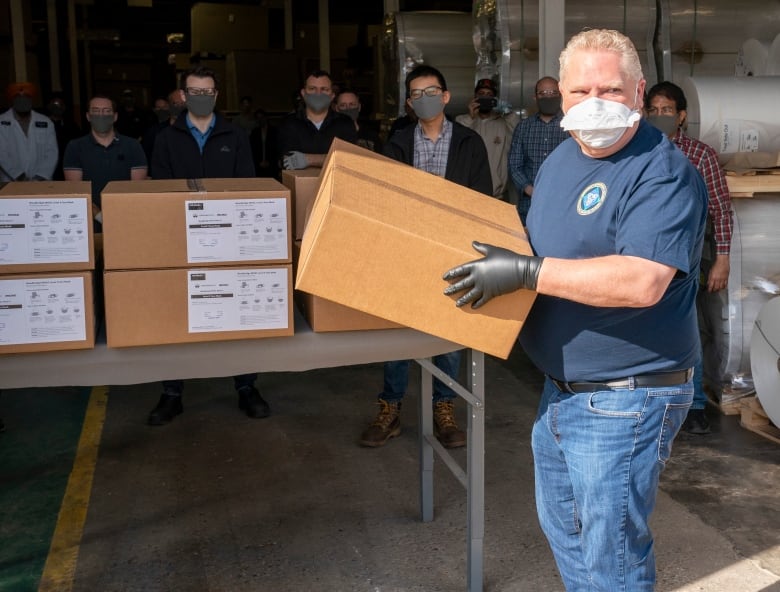Canada's manufacturing heartland faces 'bumpy road' back, uncertain future after COVID-19

This story is part of The COVID Economy, a CBC News series looking at how the uncertainty of the coronavirus pandemic is affecting jobs, manufacturing and business in regions across Canada.
It was in late March that a prominent national trade association released a bleak report forecasting the worst year for Canadian manufacturers since the Great Recession of 2008.
A little more than two weeks later, the group’s president and CEO says the dire warning may be in need of an update.
“I think that might have been optimistic,” said Dennis Darby, president and CEO of Canadian Manufacturers and Exporters (CME), which is forecasting a 5.7 per cent decline in output for 2020, after more than a decade where growth ranged from around –1 to four per cent.
“It all depends on the speed at which Canada and the U.S. come back.”
With the novel coronavirus still wreaking havoc on health care systems and interventions to slow its spread choking the economy, Canada’s manufacturers are simultaneously riding out an unprecedented shock while also planning for an uncertain future.
In Ontario, which accounts for nearly half of Canada’s manufacturing output, the drop in production has already contributed to the loss of 31,600 jobs, according to Statistics Canada’s labour survey for March.
By contrast, Quebec, Canada’s second largest manufacturer, lost only 1,200 manufacturing jobs in March, though employment figures are expected to fluctuate as new data becomes available.
While most of Ontario’s auto assembly plants have been temporarily closed due to the virus, a host of other facilities remain open, including those in food production and medical manufacturing. Darby says many of them are struggling due to dwindling cash flow and disruptions to their supply chains.
“It’s regrettable and it’s caused a lot of damage,” he told CBC News.
Darby recognizes that productivity won’t return to typical levels until international trade returns to normal, trading partners begin to reopen their economies and consumers start buying things again. For some, it may never return.
The list of variables doesn’t seem poised to stabilize for the foreseeable future.
“That’s the great unknown right now,” he said.
Industry was slumping before pandemic
The blow to Ontario’s manufacturing industry comes on the heels of a steady decline that had already weakened the sector, which accounts for more than 12 per cent of Ontario’s GDP.
“Heading into the virus, [Ontario manufacturing] was in a little bit of a tough spot,” said Rishi Sondhi, an economist at TD Bank.
Nationally, manufacturing sales had declined for five straight months leading to January, a stretch that included the closure of GM’s Oshawa assembly plant in December 2019 and, later, rail blockades in support of the Wet’suwet’en hereditary chiefs that hobbled freight train traffic.
Read other stories in the series:
Rishi says manufacturing activity has “severely” contracted during the pandemic. TD Bank expects the sector to begin a recovery in the second half of 2020, though there are many questions still unanswered about what the process will look like.
“I think it’s safe to say demand will remain muted for some time yet,” Rishi said. “It will be a bumpy road.”

The province has pledged to help struggling businesses of all types recover, in part through its new Jobs and Recovery Committee, which has started work on a post-pandemic plan.
Premier Doug Ford has also promised to “ignite a fire” and jump-start the provincial economy when it is safe to do so, but there are no details yet on how this will be achieved.
Mulling long-term change
There is also a belief that Ontario’s manufacturing sector could be irrevocably changed after the COVID-19 pandemic, and perhaps in some ways that will make the industry stronger.
Darby said the crisis has revealed the extent to which Ontario relies on supplies and goods from other regions, and the possibility that we could start producing some of them in the province.
For instance, in the face of shortages of medical equipment, some Ontario manufacturers altered their facilities to produce goods such as hand sanitizer and medical scrubs, while others have pledged to start building ventilators.
Darby said the quick mobilization of Ontario companies shows untapped potential that could be accessed through faster approvals and fewer regulations.
“If we can do it under crisis, maybe we should do it all the time,” he said.
Sondhi warns that large structural changes may not extend to industries more reliant on international supply chains, such as the auto sector.
He also notes that manufacturers may have to enforce physical distancing rules in their plants for many more months, a restriction that will weaken efforts at restoring productivity.





